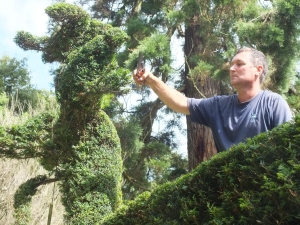The work of one of our gardeners, James Dorrian was recently featured in the Newtownards Chronicle, I thought I should share it with all our blog readers too. Jill who writes the posts for this blog will be returning soon to tell you more interesting stories of her work at Mount Stewart, hopefully this post will satisfy all you eager readers in the meantime!
All the very best,
Lyndsey (Web-Editor)
Thursday 22 August 2013
Yew clippings from Mount Stewart’s topiary are being used in the manufacture of anti-cancer drugs
The intricate yew topiary at Mount Stewart has delighted visitors for decades, but the trees are more than just attractive designs.
The topiary is rich in allegory with creatures from Celtic myth and historical symbols from the region all represented. The painstakingly clipped figures that surmount the shaped hedge around the Shamrock Garden tell the story of the Stewart family’s arrival in Ulster, from Scotland, to hunt for a stag.
With so much topiary to maintain a considerable amount of yew clippings are generated.
Normally these would be destined for composting but now these clippings are being used for a much more productive use. The manufacture of anti-cancer treatment drugs paclitaxel (Taxol) and docetaxel (Taxotere).
Taxus Bacctata (common yew) contains a complicated enzyme which when processed is used to reduce tumor size and facilitate surgery. Artificial synthesis of this enzyme has so far proved elusive to science and the only source is from varieties of yew.
The Gardener responsible for Mount Stewart’s topiary is local man James Dorrian.
“My Uncle Terry created much of the iron framework for the topiary. It’s great to think that years later I’m involved in helping maintain and fine tune these fantastic pieces. Visitors are often telling me that the topiary at Mount Stewart is unique in that it tells a story. Now we can also tell the story of how the clippings are used to create such an important medicine. It’s amazing to think that medications are derived from plants that have been found in the far flung corners of the world but this is a very important drug manufactured from our own common yew.”
The yew clippings are collected by Peter Talbot of Limehurst Ltd. Peter said:
“Limehurt have been harvesting plants in the mainland for use in medicine for 20 years, but the operation in this part of the UK has only started recently.
“The National Trust do great work in preserving our heritage and it’s great to see such an outstanding level of craftsmanship in the topiary here. We are delighted that the conservation charity is collecting their yew clippings at Mount Stewart to help us in this important work.”
The inspiration for Mount Stewart’s topiary figures was largely drawn from Queen Mary 1st ‘Book of Hours’ (Queen Mary’s Psalter). The gardens creator Edith, Lady Londonderry elaborates on this source material in her 1956 guide to the gardens at Mount Stewart.
‘All the weird animals, devils, boats and birds are drawn in the margin of the leaves (of the Book of Hours); all we did was to substitute members of the family for the originals.’
For more information on Limehurst’s work, contact Peter Talbot at limehurstireland@icloud.com

